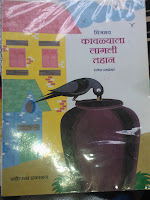 We love the fact that today many publishers are working actively towards promoting children's books in regional languages. At The Story Palce, we are keenly working at incorporating Hindi and Marathi books (Tulika and Pratham Books) in our storytelling sessions, and building lesson plans around them.
We love the fact that today many publishers are working actively towards promoting children's books in regional languages. At The Story Palce, we are keenly working at incorporating Hindi and Marathi books (Tulika and Pratham Books) in our storytelling sessions, and building lesson plans around them.As part of our research, I picked up a Marathi story today, and tried it out with my 4-year-old daughter. Since we live in Mumbai, Maharashtra, she has been exposed to a fair share of Marathi through the house help at home. The help has been speaking Marathi to my daughter since three years now, so my daughter has a good understanding of the language and can speak Marathi well (better than me).
This morning's story was "The Thirsty Crow" in Marathi, a story that we have all heard as children. I read the story slowly, explaining each part as I read it. The illustrations in the book were very simple and helped a great deal in understanding the sequence of events in the story.
After the story was over, I asked my daughter, if it was really possible to bring up water in a pot by putting stones in it. She just shrugged her shoulders. It made me think, that as a child I too had heard this story, but I never ever thought of finding out if the pebble thing worked. So, here was a chance to satisfy my curiosity and my daughter's too.


We went to the kitchen, and filled little water in a glass. I told her to pretend that she was a crow, and to try drinking the water by putting her mouth in the glass. Since the water level was low, she couldn't reach the water. So, we decided to do what the crow did. We collected some stones and put them in the glass. Slowly, slowly, the water rose up in the glass, and eventually it reached the top. The little pretend crow could drink it and satisfy her thirst!
I explained that the stones occupied space at the bottom of the glass, and pushed the water up. Later, we discussed what we (humans) would do in such a situation, one option was to lift the glass with our hands and drink water, and the other was to use a straw and suck up the water.
Who ever thought that a simple story could be so so so much fun!
Who ever thought that a simple story could be so so so much fun!
If you have read children's stories in regional languages, then do share your recommendation list with us.
































